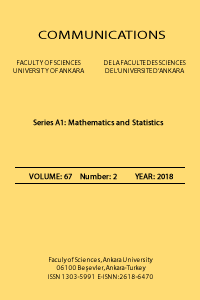A mathematical analysis of cooperativity and fractional saturation of oxygen in hemoglobin
A mathematical analysis of cooperativity and fractional saturation of oxygen in hemoglobin
Hemoglobin (Hb), cooperativity, steady states, ordinary differential equations rate equations, fractional saturation,
___
- Barcroft, J., Hill, A. V., The nature of oxyhemoglobin, with a note on its molecular weight, J. Physiol., 39 (1910). doi: 10.1113/jphysiol.1910.sp001350
- Barcroft, J., The combinations of hemoglobin with oxygen and with carbon monoxide. II. Biochem J., 7(5) (1913), 481-491. doi: 10.1042/bj0070481
- Eaton, W. A., Henry, E. R., Hofrichter, J., Mozzarelli, A., Is cooperative oxygen binding by Hemoglobin really understood, Arch. Physiol., 16 (1904). doi: 10.1038/7586
- Brian, I., Mathematical Modeling in Systems Biology: An Introduction, 2012.
- Cattoni, D. I., Chara, O., Kaufman, S. B., Flecha, F. L., Cooperativity in binding processes: new insights from phenomenological modeling, Plos One, 10(12) (2015) e0146043. doi: 1371/journal.pone.014604-3
- Chien, HO. Y., Hemoglobin: Cooperativity in Protein - Ligand Interactions. In: Encyclopedia of Life Sciences (ELS), John Wiley Sons, Ltd: Chichester, 2010. doi: 10.1002/9780470015902.a0001345.pub2
- David, L. N., Cox, M. M., Lehninger, Principles of Biochemistry, 4th edition, W.H. Freeman and Company New York, 2005.
- Edsall, J. T., Blood and hemoglobin: The evolution of knowledge of functional adaptation in a biochemical system, part I: The adaptation of chemical structure to function in hemoglobin, J. Hist. Biol., 5 (1972). doi: 10.1007/BF00346659
- Ferrell, J. E., Tripping the switch fantastic: how a protein kinase cascade can convert graded inputs into switch-like outputs, Trends Biochem. Sci., 21 (1996). doi.org/10.1016/S0968-0004(96)20026-X
- Ferrell, J. E., Self-perpetuating states in signal transduction: positive feedback, double -negative feedback and bistability, Curr. Opin. Cell Biol., 14 (2002). doi: 10.1016/s0955-0674(02)00314-9
- Francisco, L. O., Herrera, A., A dynamical model for a cooperative enzyme, J. Theor. Biol., 154 (1992). doi: 10.1016/s0022-5193(05)80402-3
- Garbett, N. C., Chaires, J. B., Binding: a polemic and rough guide, Methods Cell Biol., 84 (2008).
- Gutfreund, H., Kinetics for the Life Sciences: Receptors, Transmitters and Catalystd, Cambridge: Cambridge University Press, 1995. doi.org/10.1017/CBO9780511626203
- Hammes, G. G., Thermodynamics and Kinetics for the Biological Sciences, John Wiley and Sons, New York, 2000.
- Bisswanger, H., Enzyme Kinetics, Principles and Methods, Wiley-Vch, 2002.
- Hill, A. V., The possible effects of the aggregation of the molecules of hemoglobin on its dissociation curves, J. Physiol., 40 (1910).
- Hill, A. V., The combinations of hemoglobin with oxygen and with carbon monoxide. I., Biochem. J. 7(5) (1913), 471. doi: 10.1042/bj0070471
- Hill, T. L., Cooperativity Theory in Biochemistry: Steady-State and Equilibrium Systems, Springer Series in Molecular and Cell Biology, Springer, New York, 1985.
- Holt, JO. M., Ackers, G. K., Kinetic trapping of a key hemoglobin intermediate, Methods in Molecular Biology, 796, Allostery: Methods and Protocols, Springer, 2012. doi: 10.1007/978-1-61779-334-9 2
- Kaihnsa, N., Safey El Din, M., Maritine, J. W. R., Cooperativity, absolute interaction, and algebraic optimization, Journal of Mathematical Biology, 81 (2020), 1169-1191. doi: 10.1007/s00285-020-01540-8
- Khanday, M. A., Introduction to Modeling and Biomathematics, Dilpreet Publishing House, 2016.
- Khanday, M. A., Bhat, Roohi., Transformation of glucokinase under variable rate constants and thermal conditions: a mathematical model, Applications and Applied Mathematics: An International Journal, 16 (2021), 953-964.
- Klotz, I. M., Ligand - Receptor Energetics, John Wiley and Sons, New York, 1997.
- Mammen, M., Choi, S. K., Whitesides, G. M., Polyvalent interactions in biological systems: implications for design and use of multivalent ligands and inhibitors, Angew. Chem., 37 (1998). doi: 10.1002/(SICI)1521-3773(19981102)37:20<2754::AID-ANIE2754>3.0.CO;2-3
- Marangoni, A. G., Enzyme Kinetics, A Modern Approach, Wiley John and Sons, Inc., Hoboken, New Jersey, 2003.
- Johnson, M. L., Mathematical modeling of cooperative interactions in hemoglobin, Methods in Enzymology, 323 (2000). doi.org/10.1016/S0076-6879(00)23364-8
- Mills, F. C., Biochemistry, 1976.
- Monod, J., Wyman, J., Changeux, J. P., On the nature of allosteric transition: A plausible model, Journal of Molecular Biology, 12 (1965). doi.org/10.1016/S0022-2836(65)80285-6
- Pertuz, M., Stereochemistry of cooperativity effects in hemoglobin, Nature, 228 (1970).
- Klein, P., Pawson, T., Tyers, M., Mathematical modeling suggests cooperative interactions between a disordered polyvalent ligand and a single receptor site, Current Biology, 13 (2003). doi: 10.1016/j.cub. 2003.09.027
- Stefan, M. I., Novera, N. L., Cooperative binding, Plos Comput. Biol., 9(6) (2013). doi.org/10.1371/journal.pcbi.1003106
- ISSN: 1303-5991
- Yayın Aralığı: Yılda 4 Sayı
- Başlangıç: 1948
- Yayıncı: Ankara Üniversitesi
A-Davis-Wielandt-Berezin radius inequalities
Verda GÜRDAL, Mualla Birgül HUBAN
Constructing directed strongly regular graphs by using semidirect products and semidihedral groups
Semih PİRİ, Oktay OLMEZ, Murat ŞAHİN
Comparison of estimation methods for the Kumaraswamy Weibull distribution
B-Lift curves and its ruled surfaces
Anıl ALTINKAYA, Mustafa ÇALIŞKAN
Hadamard product of holomorphic mappings associated with the conic shaped domain
Syed Zakar HUSSAİN BUKHARİ, Aamir SHAHZAD
$q$-Difference Operator on $L_q^{2}( 0, + \infty )$
A mathematical analysis of cooperativity and fractional saturation of oxygen in hemoglobin
Roohi BHAT, Mukhtar Ahmad KHANDAY
Esra KIR ARPAT, Turhan KÖPRÜBAŞI
Comparison of some dynamical systems on the quotient space of the Sierpinski tetrahedron
